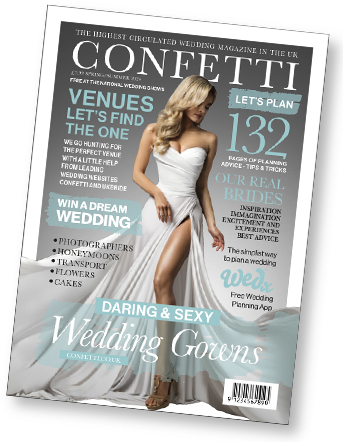Make sure that you stand out for all the right reasons with Confetti’s guide to wedding dress codes.
Cracking the dress codes
Fancy dress
Always a brilliant idea at the time, fancy dress needs careful handling if it’s not to be a headache.
If you’re the host, make sure that everyone knows that it’s compulsory to dress up ‐‐ there’s nothing worse than a party full of normally dressed people with the odd Cleopatra or Charlie Chaplin wandering round like a lost street performer.
If you’re the guest, make sure you do dress up. We know the nightmares about turning up dressed as Mickey Mouse and finding no one else has bothered, but that’s not really going to happen, is it? For a start, rope in all your friends, so there’s some safety in numbers. You could also have fun gathering together beforehand to work out your costume ideas.
But if you’re still not confident going the whole hog on your Piglet outfit, at least try to make some effort. If the theme’s Fantasy, for instance, how about getting a pair of angel wings? Easy to whip off if you feel uncomfortable and they’ll allow you to enter into the spirit of things. Most of all, remember the thought that’s gone into planning the occasion ‐‐ you owe it to your host to get involved.
And finally…
The most important thing about dress codes is that you feel comfortable in whatever you’re wearing. Then you’ll be able to pull off your outfit without having to physically pull it all off and change into someone else. If you’re stuck about what to wear, ask your friends and anyone you know who is invited. And if you’re absolutely stuck, call the hosts. They’ll be only too happy to advise.
We’ve all uttered the cry minutes before a big night out: “But I don’t know what to WEAR!” It’s a perennial problem: how to avoid fashion faux pas and sidestep the mutton‐dressed‐as‐lamb label, while at the same time choosing an outfit that’s suitable for the occasion AND will blow everyone away with your sense of style and taste.
Always stick to the dress code
If it says “casual” on the invitation, dress casually. But remember: “casual” in a wedding or special occasion context usually means a smarter than usual. And don’t forget the golden rule of party going: it’s much better to be a bit smarter than everyone else than to turn up looking like a poor relation. “Casual” means comfortable, but not complacent.
White tie
Knowing the difference between black tie and white tie is an age‐old problem. Briefly, white tie for men means a tail coat, one formal step up from a dinner jacket (though you can just about get away with the traditional dinner suit). Also, white tie definitely means no spotty or gimmicky bow ties ‐‐ stick to a white bow tie, stiff white shirt and waistcoat. For women, white tie definitely means a long dress rather than a short one (that means three‐quarter length at the shortest).
Black tie
Unless things are getting VERY formal, black tie is a much more common dress code requirement. It’s also more flexible. Choose something sexy, glam and smart. It needn’t be expensive, but it does need to scream class. It’s the easy tuxedo or dinner suit for men, but it’s a bit harder for women. Choose a smart dress, heels and a wrap or separates with an evening feel.
Formal dress
Anything on an invitation that hints at formal dress usually means black tie, though you can allow for a bit more flexibility. It can range from a smart suit (though preferably not your work one, to a cocktail or long dress.
Smart/casual
For men, this tends to mean a shirt and tie, usually, but not always, with a jacket. For women, it’s a dress, skirt or smart pair of trousers. In fact, this is the perfect dress code for after work. You can jazz up your office gear with a pair of higher than normal heels, some jewellery and a glamorous top.

